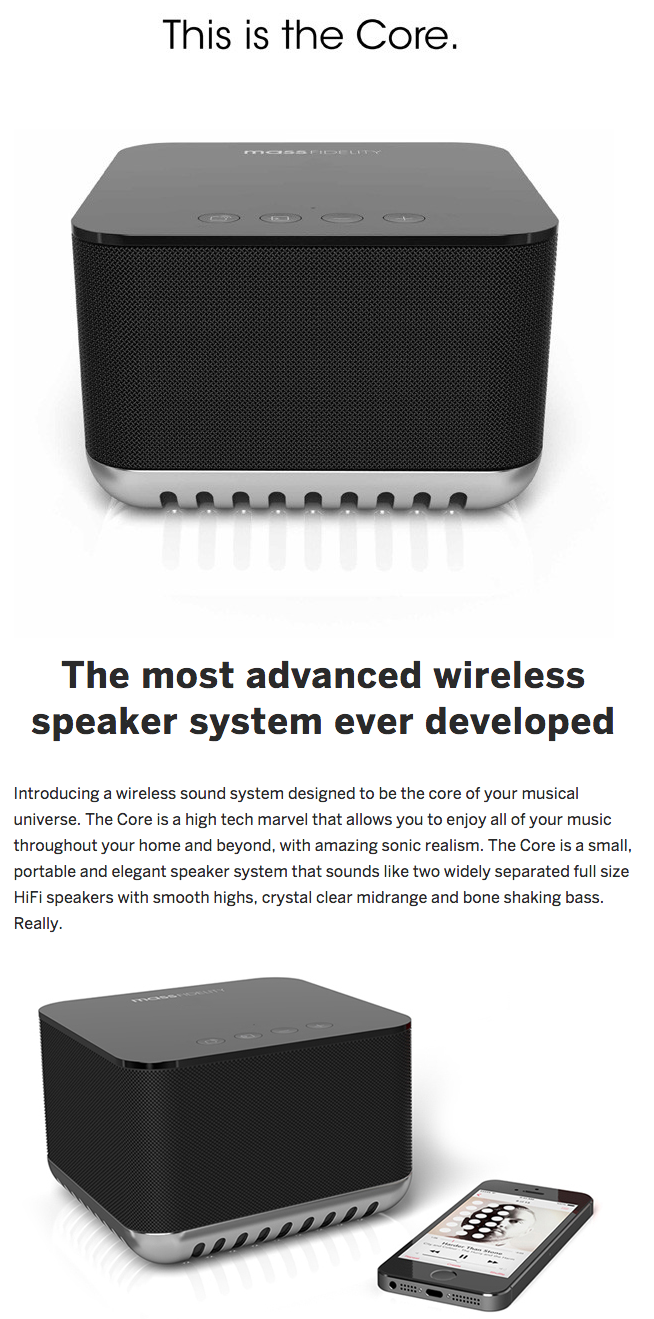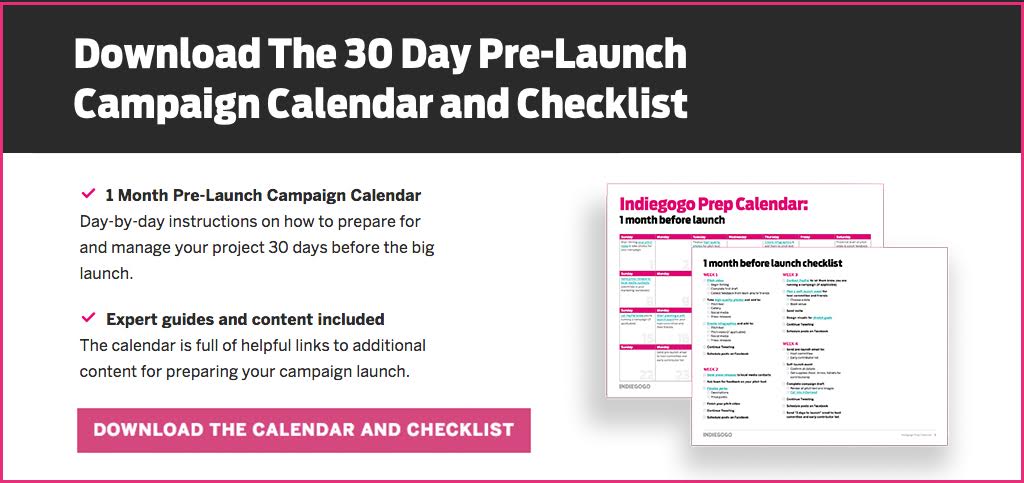Last week, we published the first campaign prep calendar and checklist in our series to help you get started two months before launch. Now you’re one month away from launching your crowdfunding campaign and ready to start creating and finalizing everything that goes into your campaign page and marketing strategy. Creating a compelling, informative and engaging campaign will help your potential backers learn more about your idea and decide whether or not they want to contribute. Based on user research and feedback from real campaigners, we’ve put together a detailed, interactive calendar and checklist for you to create the perfect crowdfunding campaign.
Tell Your Story
The three main elements of the campaign creation phase are the video, visuals and pitch text.
Pitch Video
Not only do campaigns with pitch videos raise 4 times more funds than those without, but videos are an extremely effective and engaging way to communicate with your target audience while offering you full creative control. Last month you storyboarded your video and possibly hired a professional to help you convey your message. Now, it’s time to start filming your video. Make sure you use the first 30 seconds to grab your audience’s attention, and keep your pitch video under 3 minutes. Check out these 6 helpful tips for a good pitch video. Once you complete your first draft, solicit feedback from your teammates, friends, family – anyone with an opinion you trust. Make edits based on feedback and finalize your pitch video. Flic does a great job explaining their value in the first 30 seconds.
Images and Infographics
In addition to your video, high-quality visuals help to quickly paint a picture of who you are and what you want to achieve. Visuals, such as infographics and product shots, are much more digestible, shareable and engaging than blocks of text. You may have chosen to hire a professional designer or photographer to help you create these visuals; regardless of whether you chose to go pro or DIY, it’s time to finalize these images for your pitch text, campaign gallery, perks, social media and press releases. Infographics are a great way to visualize data and facts and are highly shareable on social media. Add any infographics you have to your pitch text, pitch video (if applicable), your social media calendar and press releases. Social media posts with images receive higher engagement than those without on both Facebook and Twitter, so be sure to include visuals wherever you can. Some excellent examples of campaigns that maximize their visuals include The Core and What Lola Wants.
Pitch Text
We’ve spent a lot of time focusing on visuals, like your video and images, but it’s equally as important to have strong pitch text on your campaign page. We recommend breaking it up into sections with headers so that it’s easy for people to quickly skim your entire campaign and still retain information. Feel free to draft sections day-by-day or all at once – whatever workflow works best for you! Here’s a general format you can follow (don’t forget to add visuals to most of these sections!):
- Intro (short 2-3 sentence summary with call to action)
- About the Project
- About the Organization/Company/Team
- Perks!
- Where the Funds Go (budget)
- Impact and/or How it Works
- Other Ways You Can Help
Once you feel comfortable with your first draft, ask your teammates, friends and family to review your pitch text and provide feedback. Based on their feedback, you can finalize your pitch text and visuals for your campaign page.

Press Releases
Last month, you identified local media contacts to reach out to within your marketing workbook, completed the media outreach worksheet and drafted press releases to share with the media. Send out your press release to local media outlets first and review these 7 tips on how to get the press to cover your crowdfunding campaign.
Become an Online Community Superstar
Building an online community is crucial to your campaign’s success, and two of the strongest tactics to use are social media and email.
Social Media
Throughout the entire planning process, you should be continually posting to Facebook, Twitter and any other relevant channels you chose to be active on. If you haven’t chosen a social media scheduling tool yet, it’s not too late! Scheduling your posts ahead of time will help you streamline your workload and keep a fresh, rotating newsfeed for your followers. In addition to consistently sharing updates and photos, you can also reach out to influencers in your space to raise awareness about your campaign. A few great examples of Facebook posts and Tweets from past campaigners:
Our Indiegogo Campaign launches in less than 24 hours: #EarthDay just after midnight EST April 22, which will be just…
Posted by Solar Roadways on Monday, April 21, 2014
Here’s what the honey channel at the bottom of a Flow™ Frame looks like during harvest. To get more information on Flow™Hives & Frames please visit: https://bit.ly/1zZlnj8
Posted by Flow Hive on Saturday, April 4, 2015
.@SBoscott you might be interested in our new invention: https://t.co/cUtY1SvEMa … honey on tap straight from the hive
— Flow Hive (@flowhive) February 15, 2015
Email List
Before you launch your campaign, it’s important to have a strong email list that will help you build early momentum and reach 30% of your goal before your official launch. This way, when people visit your campaign page, they’ll see that you already have a strong base of support and will feel more comfortable contributing their own funds to your project. Once you have your campaign team established, ask each team member to create a list of folks that can be added to your network of early supporters and host committee. Your host committee consists of people that you can rely on to help you reach your goal and also reach out to their own networks to help spread the word about your campaign. Your early supporter network is a much larger group that consists of anyone who might be interested in your project. Any other contacts you’ve gathered can be bucketed into various other lists for you to reach out to after the official launch.
Once you have your lists finalized and verified via the email calculator, send a series of pre-launch email to both the host committee and early supporter network, including an invite to your soft launch (more on that later), a pre-launch announcement and a “3 days to launch” email.
Create Your Campaign
You’ve finalized your pitch video, pitch text and visuals for the campaign page. Collaborate with your team members to finalize perk descriptions, images and price points and input everything into your campaign draft. If you’ve chosen to receive funds via PayPal, let them know you’re running a campaign. Did you design stretch goals last month? Time to design visuals to go along with them. When filling out your campaign draft, you have the option to opt into InDemand, our service that allows you to continue raising funds, accept pre-orders and build community even after your crowdfunding campaign ends. Ask your teammates and friends for feedback on your completed campaign draft and make edits as needed. You’re almost there!
Plan Your Soft Launch
While your official launch date includes email outreach to your network and social media posts, a soft launch is a more intimate launch before the official launch that involves getting your host committee and early supporter network to be the first contributors to your campaign. A soft launch with this group of people will help you reach at least 30% of your goal before the public sees the campaign, giving others a sense of comfort and trust when considering contributing.
First, create an invite list of those who you know will support you and contribute to your campaign. Plan the logistics for your event, such as sending invites, booking a venue, ordering supplies (food, drinks, tablets for contributions), drafting emails for folks to share with their networks and so forth. Your soft launch event can be as informal or as elaborate as you’d like. In your invitations and pre-launch emails, mention how much you appreciate their support, whether they choose to contribute funds or help spread the word about your project. By setting a hard deadline for them to contribute by, you can ensure that your campaign page is at the percentage of funds raised you want to be at for the official launch.
Photo via Coffee Meets Water: An Exhibit of Photos and Film Event from Good Neighbors USA
After all this preparation and your soft launch, you’re ready for the official launch! Stay tuned for part 3 of our series: Running & Managing Your Campaign and After the Campaign.
Download our free, interactive and printable prep calendar and checklist for one month before your crowdfunding campaign launch:
8 Responses
You must be logged in to post a comment.








Can’t launch my campaign. Says I need to fill out requirments for Extras Section. but it doesn’t highlight which section.
Still can’t find anything on HOW to do the soft launch.
Pages and pages and pages on what the goal of a soft launch is and how to promote it, but not on HOW to actually DO a soft launch – like what steps need to be taken.
intresting)))
Part 3: Expert Tips for Running a Successful Crowdfunding Campaign [Free Calendar and Checklist] at https://go.indiegogo.com/blog/2015/12/running-successful-crowdfunding-campaign-calendar.html
Part 3?
This is GREAT! Where is part 3???
Very great article!
The DuoKeyCharge makes charging your smartphones and tablets simple and easy! No more tangled wires. No more hassles. Check our Indiegogo campaign “DuoKeyCharge for iPhone/Android/MicroUSB devices”
https://igg.me/at/DuoKeyCharge/x
Great